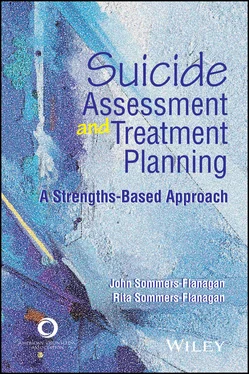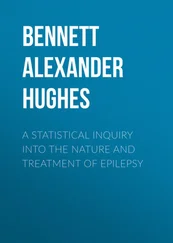John Sommers-Flanagan - Suicide Assessment and Treatment Planning
Здесь есть возможность читать онлайн «John Sommers-Flanagan - Suicide Assessment and Treatment Planning» — ознакомительный отрывок электронной книги совершенно бесплатно, а после прочтения отрывка купить полную версию. В некоторых случаях можно слушать аудио, скачать через торрент в формате fb2 и присутствует краткое содержание. Жанр: unrecognised, на английском языке. Описание произведения, (предисловие) а так же отзывы посетителей доступны на портале библиотеки ЛибКат.
- Название:Suicide Assessment and Treatment Planning
- Автор:
- Жанр:
- Год:неизвестен
- ISBN:нет данных
- Рейтинг книги:4 / 5. Голосов: 1
-
Избранное:Добавить в избранное
- Отзывы:
-
Ваша оценка:
- 80
- 1
- 2
- 3
- 4
- 5
Suicide Assessment and Treatment Planning: краткое содержание, описание и аннотация
Предлагаем к чтению аннотацию, описание, краткое содержание или предисловие (зависит от того, что написал сам автор книги «Suicide Assessment and Treatment Planning»). Если вы не нашли необходимую информацию о книге — напишите в комментариях, мы постараемся отыскать её.
Suicide Assessment and Treatment Planning — читать онлайн ознакомительный отрывок
Ниже представлен текст книги, разбитый по страницам. Система сохранения места последней прочитанной страницы, позволяет с удобством читать онлайн бесплатно книгу «Suicide Assessment and Treatment Planning», без необходимости каждый раз заново искать на чём Вы остановились. Поставьте закладку, и сможете в любой момент перейти на страницу, на которой закончили чтение.
Интервал:
Закладка:
6 If necessary, contact child protective services to possibly open a neglect case: “If the parents/guardians intentionally do not seek help for their child with the first notice, the standard of care for the profession is that the school counselor makes an outreach to the family reiterating the suicide risk, the urgency to seek help for their child and the acknowledgement that a neglect case has to be lodged with” child protective services (para. 24).
Stone (2018) and the American School Counselor Association (2020) make it clear that whenever suicide is linked to a specific student, professional school counselors are mandated reporters. Although school counselors may participate in formal suicide assessment protocols, if suicidal ideation is reported, parents or caregivers are contacted. The clarity of this position relieves the school counselor of uncertainty. However, this black-and-white guidance on suicide reporting leaves some school counselors wishing they could exercise their judgment. Given that reporting suicidal ideation to parents or caregivers can rupture the therapeutic relationship and initiate a cascade of negative responses, some professionals question the need for school counselors to always report even minor suicidal ideation.
The reason why school counselors need to report is probably best summed up by the Latin phrase in loco parentis , which means “in place of a parent.” Essentially, when parents are not present, school professionals assume and discharge parental duties. When it comes to suicidal ideation, most professionals, including attorneys, are likely to interpret this principle as meaning that parents or caregivers deserve to be informed when their children talk about suicide. The way we think of this is that school counselors and other professionals working with children should view suicidal ideation as a sign of intense distress, and unless there is evidence of child abuse, parents should be informed when evidence indicates their child is in intense distress. Furthermore, a useful frame to take with parents is to identify support and/or interventions designed to decrease student distress.
Informed Consent
Ethical counseling flows from informed consent. As a counseling professional, it is your job to make sure clients, students, and parents understand and consent to the rules and parameters of counseling—including the limits of confidentiality.
Informed consent is a clinical process that involves written documentation, an oral description, and an opportunity for questions and discussion. The process and documentation capture the professional background, the theoretical orientation(s), agency or school policies, emergency policies and procedures, and other matters specific to your setting, but in this text we only provide guidance for the portions related to potential suicidality.
If you are currently working with clients, students, or patients without a standard informed consent process, we highly recommend you develop one and use it. Both you and your clients are at risk without a clear informed consent document and process. There are three distinct but related components to informed consent. We cover these components here, with examples that may need fine-tuning depending on your setting.
Confidentiality and Its Limits
When clients, students, or others in distress talk with mental health or school counseling providers, they usually assume that what they say will be held in confidence. This is mostly true, but confidentiality exists only when a formal professional relationship has been established. For example, if teachers contact you about student behavior or parents contact you and offer information about their child, you may or may not be required to hold that information confidential. These are situations when you should spell out limits of confidentiality in advance, before inaccurate assumptions take hold.
It is up to you to explain what you can and will keep confidential and what you cannot keep confidential. Intent to harm oneself or others is an almost universal reason for mental health, health, and school professionals to break confidentiality. Some professional ethics codes directly or indirectly allow for maintaining confidentiality when clients are terminally ill and may be considering ending their lives (Werth et al., 2002). Technically, such plans and considerations would be labeled “suicidal,” but this is a vastly different situation than the ones we are writing about in this book. State laws, ethics codes, agency policies, and school rules dictate or influence what can and cannot be held in confidence. You should practice presenting information about confidentiality and its limits accurately, in understandable language, to clients, parents, teachers, administrators, and other community or school professionals (e.g., police officers). Here is an example aimed at an adolescent population:
As your counselor, I will keep nearly everything you tell me private. We call this confidentiality. This is important for a trusting relationship. For example, if we see each other in public, I’ll be careful not to greet you unless you greet me first, because the fact that you’re seeing me for counseling is nobody else’s business. That’s how private this relationship is. But there are a few exceptions we should talk about.
1 Your parents. Your parents have a right to ask for my counseling records. That doesn’t mean I’m going to tell them everything you say, but they can ask to see my notes. Most parents don’t ask to see my notes because they agree that what you and I talk about should be just between us. We will work together on reaching an understanding with your parents so we both know what to expect. If your parents, friends, or others tell me things about you that will help in our counseling, I will let you know. They’re important people in your life, but they’re not my clients. I won’t keep secrets for them, and I’ll make that clear to them if they speak with me.
2 Danger. If what we talk about leads me to believe you’re in danger of hurting yourself or someone else, by law I have to act to keep you or others safe. But the first thing I would do is talk directly with you about how to do that. If I believe it’s necessary to call someone, I will make every effort to tell you first. My most important priority is to help you. If you’re in danger, I may need to contact others to help keep you safe.
3 Abuse. If I suspect that you, or anyone, is being abused, the state requires that I make a report to child protective services. This could involve sexual abuse, physical abuse, or neglect. If I suspect this, I’ll ask you about it directly and then I’ll tell you if I need to make a report.
4 Questions. Do you have any questions about your privacy or confidentiality with me?
There are other reasons why counselors breach confidentiality, such as for insurance paperwork or court orders, but these details are typically addressed in written informed consent documents.
Social Media and After-Hours Contact
Social media is now so ubiquitous that school and mental health professionals must address it within the informed consent process (Wheeler & Bertram, 2019). In some cases the messaging can be simple, as in an informed consent form that reads “Please note that because of ethical issues, I don’t socialize with clients outside of scheduled professional appointments, including through social media.” A specific statement such as the following might be useful:
In my counseling work, I do not use Facebook, Instagram, Twitter, or other such platforms to interact with clients. I have a Facebook page that I use for personal and social reasons, but I don’t friend my clients and I don’t accept friend requests from them. My goal is to keep our relationship professional.
Читать дальшеИнтервал:
Закладка:
Похожие книги на «Suicide Assessment and Treatment Planning»
Представляем Вашему вниманию похожие книги на «Suicide Assessment and Treatment Planning» списком для выбора. Мы отобрали схожую по названию и смыслу литературу в надежде предоставить читателям больше вариантов отыскать новые, интересные, ещё непрочитанные произведения.
Обсуждение, отзывы о книге «Suicide Assessment and Treatment Planning» и просто собственные мнения читателей. Оставьте ваши комментарии, напишите, что Вы думаете о произведении, его смысле или главных героях. Укажите что конкретно понравилось, а что нет, и почему Вы так считаете.











